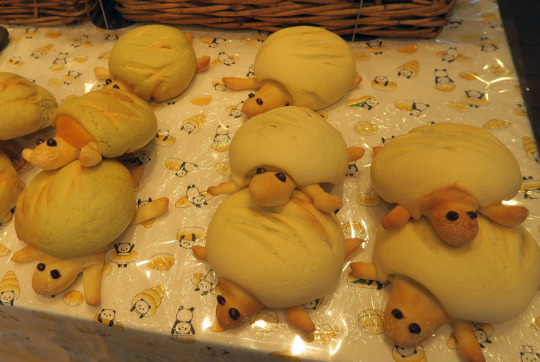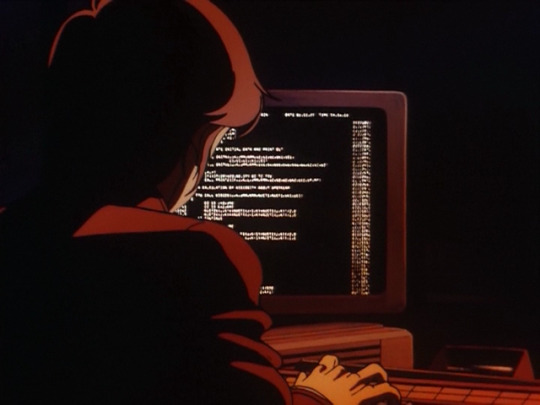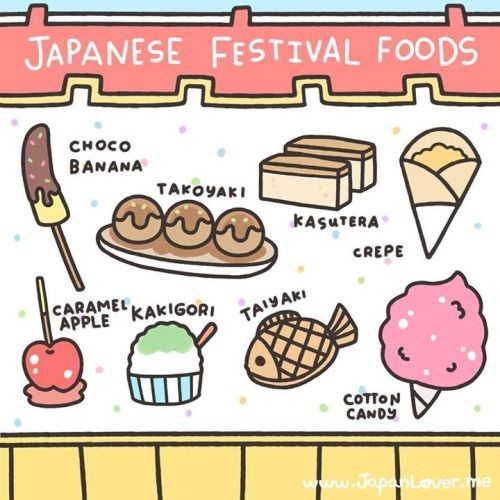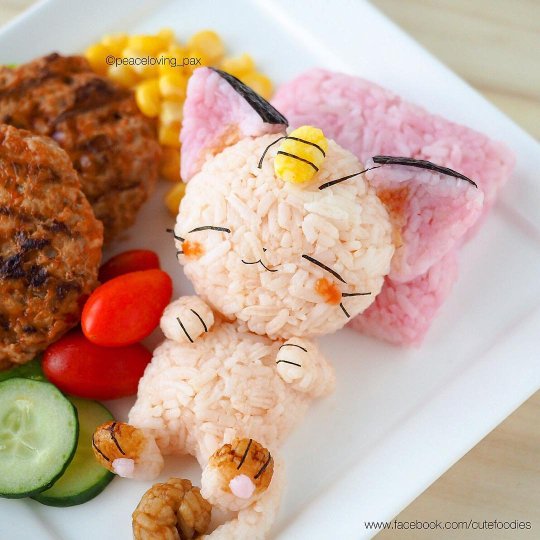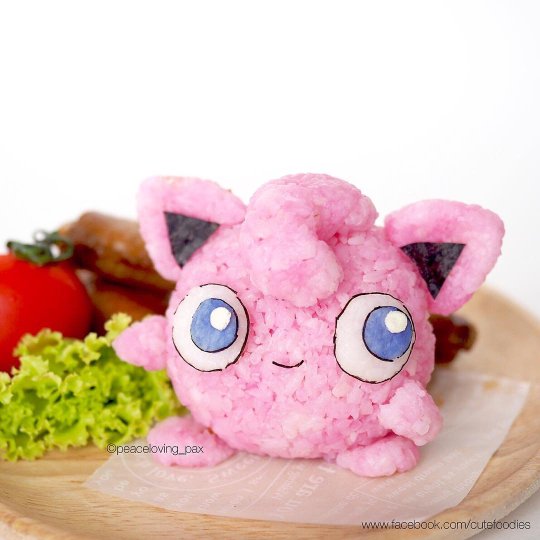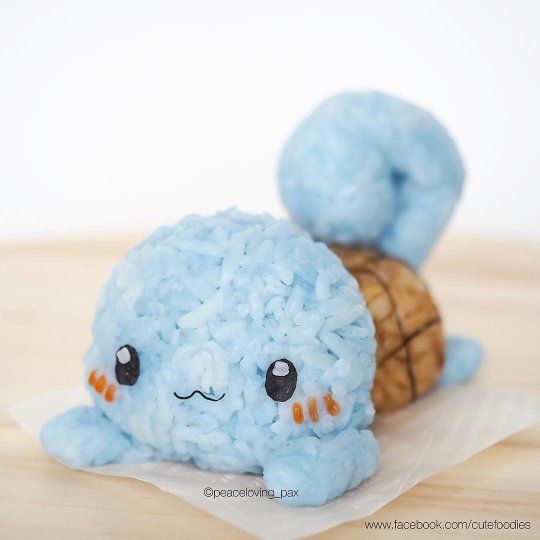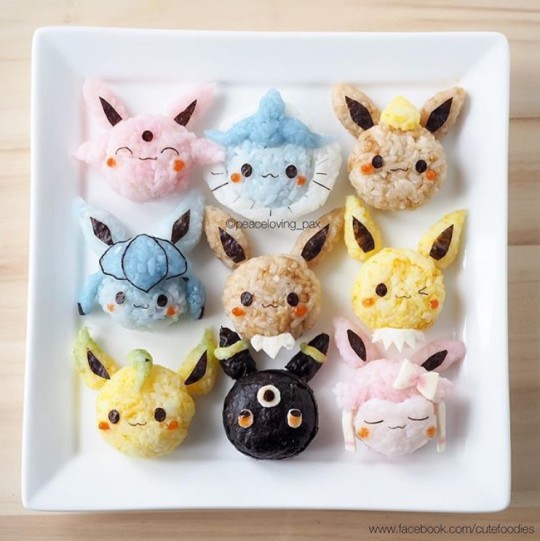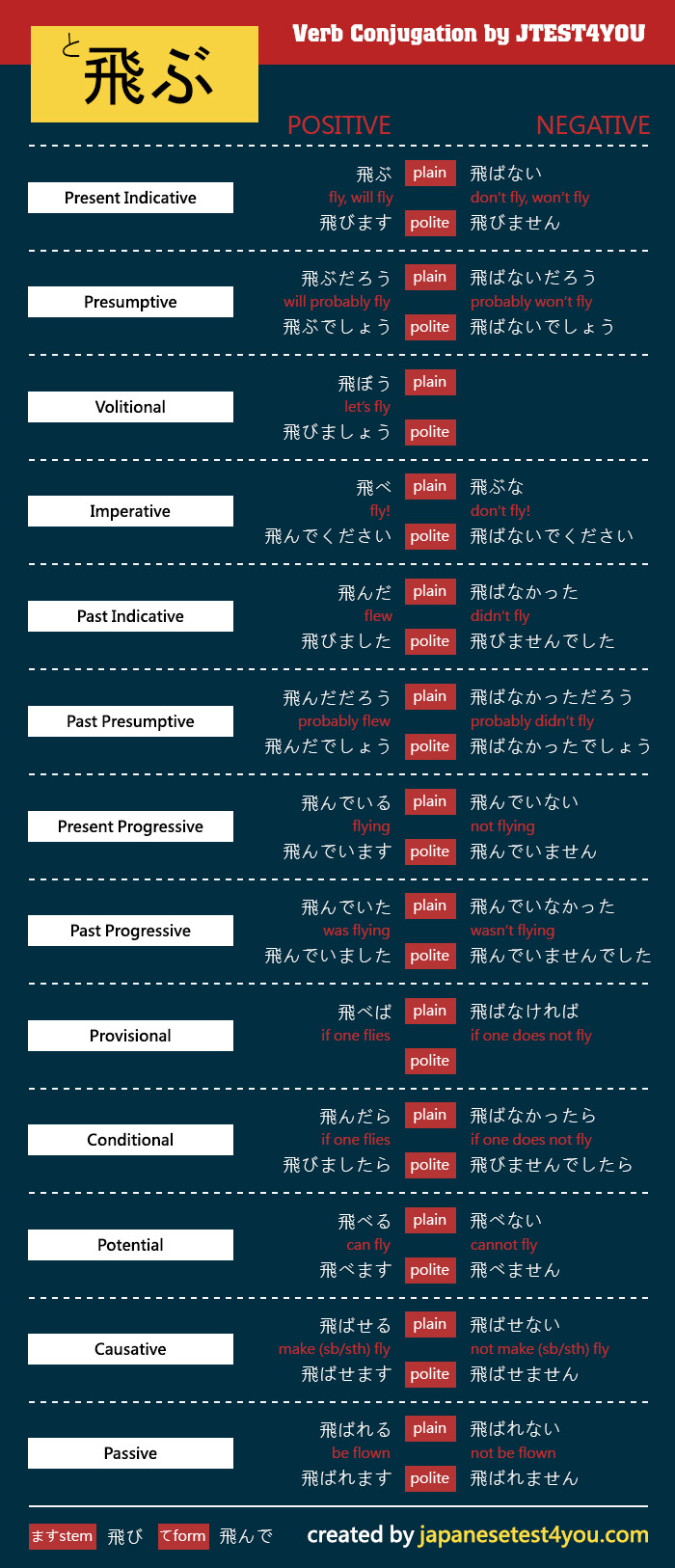Photo
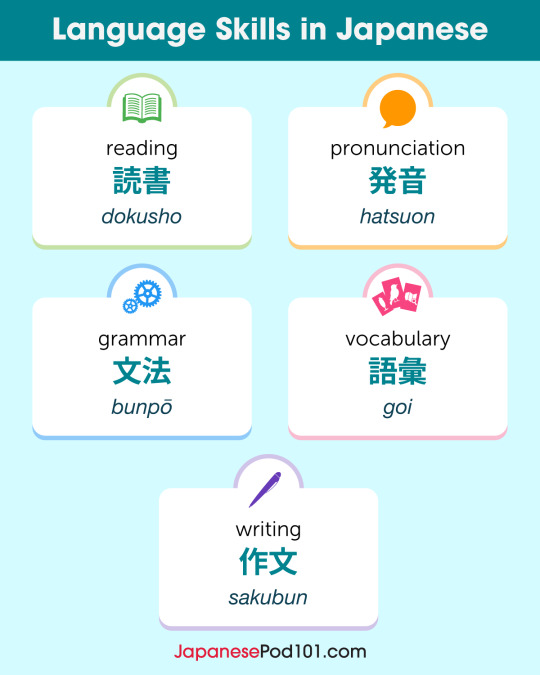
Language Skills in Japanese ⚙ PS: Learn Japanese with the best FREE online resources, just click here: https://www.japanesepod101.com/?src=social_special_infograph_skills_020420
147 notes
·
View notes
Photo

Most Common Adjectives 💡 PS: Learn more about Parts of Speech in Japanese, just click here: https://www.japanesepod101.com/?src=social_special_infograph_adjectives_10_020620
207 notes
·
View notes
Text
Japanese Resources Masterpost Updated
Online resources
Erin Japanese video courses
Watanoc reading practice
Genki Kanji reading practice
jGram Grammar
Maggie Sensei – grammar lessons
WaniKani
Tofugu Japanese Culture & Language Blog
Jisho dictionary
Kanji by frequency
Learn Hiragana
Japanese.io plugin
Memrise Japanese courses
A PDF on conjunctions
Tae Kim’s Guide to Learning Japanese
How I learn Kanji – on my tumblr
Steps to learn Japanese sentence structure – on my tumblr
JLPT
JLPT Kanji lists
Japanese Test 4 You
JLPT Grammar resources
Podcasts
Bilingual News
HKBK fm – discontinued but you can still listen. Wide variety of topics!
Slow Japanese
Japanesepod101
YouTube channels for learning
Japan Society NYC
Nihongo No Mori
Japanese Pod 101
Shota Sensei
BondLingo
Japanese Ammo With Misa
YouTubers and vloggers
Mimei
Dogen
Micaela
Nanako
Loretta Kemushi Chan
Hajime
Mahoto
Hikakin
PeachMilky
Noah Sato
My favorite Japanese show ever
Terrace House on Netflix
1K notes
·
View notes
Photo
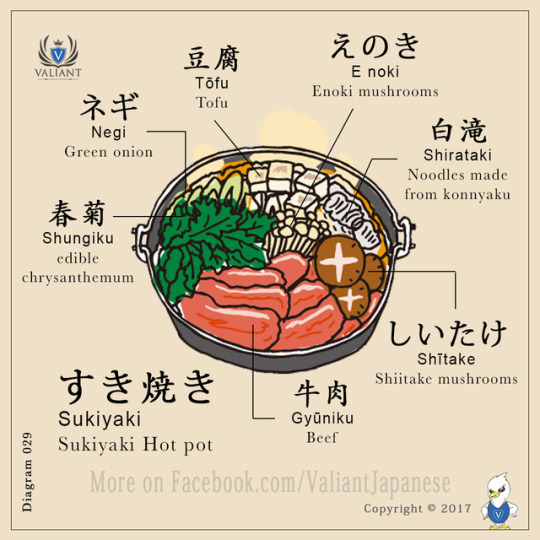

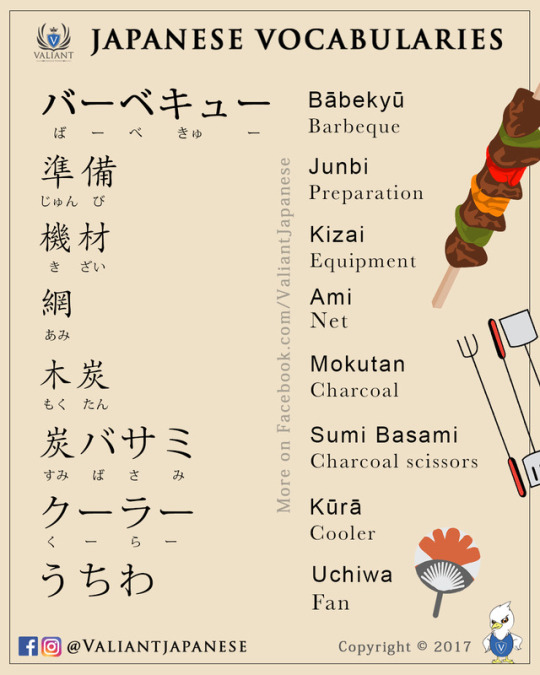
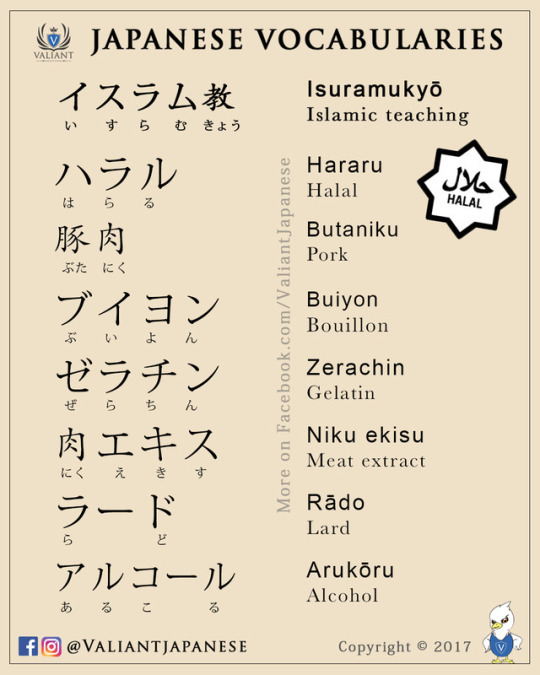
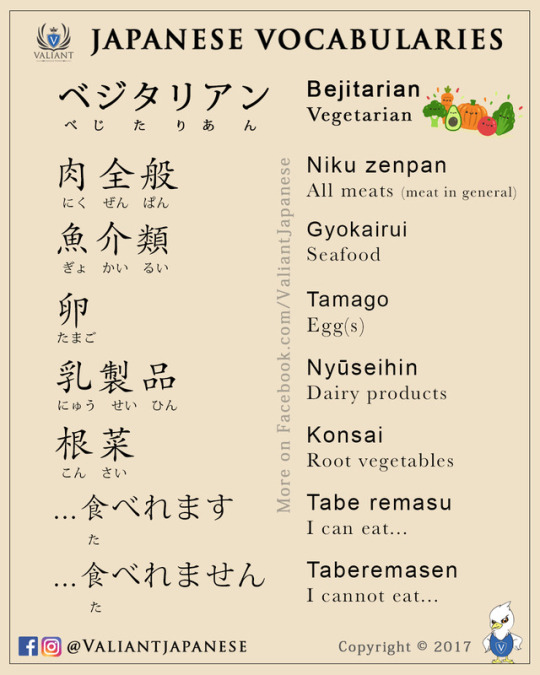
Eating some foods in Japan? take note of these vocabulary
More Flashcards all available at www.instagram.com/valiantjapanese
3K notes
·
View notes
Photo

Japanese for Total Beginners || How and Where to Start Studying
Hey guys, I’m going to try and answer my most commonly asked questions that I continuously receive in the next following weeks so if there’s anything you’d like answered feel free to submit your questions. I’m also going to try and find a new theme as a lot of you guys have mentioned that you’re unable to view my FAQ page while on your mobile devices so once I’ve found a good theme I’ll ask you guys to check it out so that you can let me know if it works or not!
This post is going to be regarding how to study Japanese as a total beginner. The single most commonly asked question that I receive (and I get asked this at least once a week since starting my blog back in 2016) is something along the lines of “I’ve never studied Japanese before but I really want to, but I have no idea where to start.” so I’m going to try and answer this question today to the best of my abilities.
WHAT SHOULD I LEARN FIRST?
I recommend starting off with learning the kana system (hiragana and then katakana). While learning how to read, write, and recognise kana, you should also spend time learning how to properly pronunciate the kana. Learning Japanese pronunciation at this step will help you a great deal as you start progressing into learning the language.
Once you’ve learnt kana you can move onto introducing basic grammar structures and basic vocabulary together. If you’re self-teaching I really recommend getting a textbook because most textbooks introduce grammar and vocabulary together in easy to understand ways. If you cannot afford to purchase a textbook there are PDFs floating around online and many websites that offer free Japanese lessons.
Once you can use kana, understand some basic grammar and vocabulary, and are able to produce your own basic sentences, I would then introduce simple kanji. This would include numbers, days of the week, months, and the kanji version of some vocabulary you’ve learnt (such as 私・わたし/食べ・たべ).
After that it’s just a matter of introducing new grammar, vocab, and kanji which will gradually increase in difficulty as you continue to progress through the language.
SHOULD I LEARN GRAMMAR OR VOCABULARY FIRST?
Vocabulary for me is mostly memorisation - memorising the meaning and the word/characters - and then simply applying the vocabulary to the grammar structure, which is why I like learning them together because I think that they tend to go hand-in-hand.
HOW OFTEN SHOULD I STUDY JAPANESE?
This really comes down to the individual as it depends on your own personal schedule and abilities. Some people ate able to study every single day and others can only do it a couple times, or just once a week. The key is finding a routine that works for you and keeping at it to the best of your abilities. They say it takes 21 days for something to become a habit.
What works best for me is studying early in the morning after waking up and then I feel I can go about my day without any concerns. I have an entire tag dedicated to immersing yourself into the Japanese language so feel free to check it out.
WHAT’S A GOOD STUDY ROUTINE?
I often get asked to provide specific details or give study routines regarding where to begin with studying Japanese so below is my recommendations on where to start.
Hiragana:
Begin with learning the 5 vowels in Japanese (A, I, U, E, O) - learn how to read, write, pronounce, and recognise them.
Continue with learning vowels + consonants (K, S, T, N, H, M, R, Y, W) - learn how to read, write, pronounce, and recognise them.
Study the exceptions (SHI, CHI, TSU, FU) - Try to memorise these in particular as they can confuse beginners quite easily.
Katakana:
Study katakana similarly to how you studied hiragana beginning with vowels, and then moving onto consonants and focusing on the exceptions.
Try to create your own flashcards in order to memorise the characters.
There are also a number of apps designed to help you recognise and memorise hiragana and katakana characters as well as to test your knowledge on them.
Vocabulary + Grammar:
I would begin with learning basic expressions such as greetings and self-introductions. I’d use the information from this website to find basic expressions and greetings.
Once you’ve memorised some basic expressions you should move onto basic grammar and vocab.
I learnt by using the Genki textbook so I recommend following their order of lessons, otherwise you can search on google for Japanese lessons to follow.
Make sure to study Japanese particles very seriously as they can often stump Japanese learners! Don’t be afraid to spend a long time studying them.
Kanji:
Once you’ve mastered kana and are comfortable with creating basic sentences in Japanese, I would start introducing kanji. As I mentioned before I would start with numbers, days of the week, months, and then kanji versions of vocabulary that you’ve already learned.
If you search “Kanji lessons” on google you’ll come across some useful websites like this one.
After this you just have to continue building up your grammar, vocab, and kanji knowledge.
Resources:
PDFs -
Genki I Textbook
Genki I Workbook
Genki I Answer Key
Genki II Textbook
Genki II Workbook
Genki II Answer Key
Genki I + II and MP3 files
Japanese For Busy People 1
Japanese For Busy People 2
Japanese For Busy People 3
Japanese For Busy People Workbook
Japanese Pronunciation -
Learn Japanese Pronunciation in 14 Minutes
Introduction to Japanese Pronunciation
Top 5 Japanese Pronunciation Mistakes to Avoid
Charts -
Hiragana Chart
Katakana Chart
Hiragana + Katakana Chart Combined
Apps -
Anki (flashcard app)
Memrise (learn Japanese)
imiwa? (dictionary app)
Learn Japanese (introduces phrases and vocab)
Learn Japanese by Mindsnacks (increases vocab)
Hello Talk (talk with native speakers)
TenguGo Kana Hiragana Katakana (introduces kana system)
Kana Quiz (test your kana knowledge)
Website -
Tae Kim’s Guide to Japanese (Study Guide + Lessons)
Jisho (online dictionary)
JapanesePod101 (Japanese lessons)
Tofugu (Japanese lessons + Cultural lessons)
4K notes
·
View notes
Photo
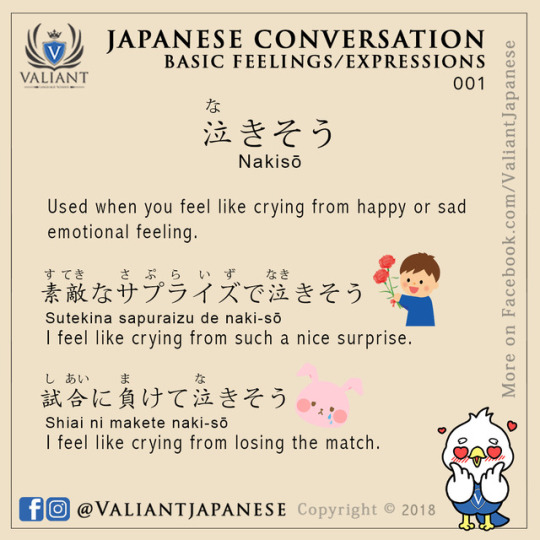
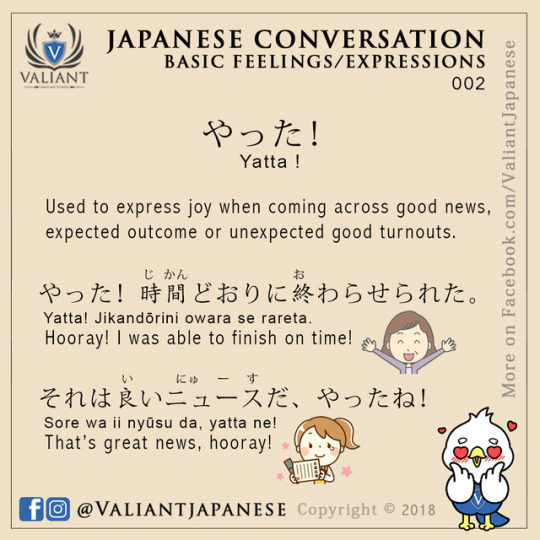


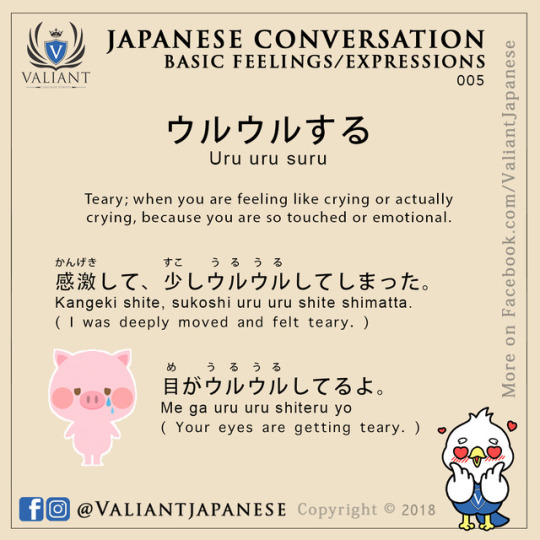
Japanese Vocabulary and Phrases: 001 to 005
More Japanese flashcards on www.instagram.com/valiantjapanese
1K notes
·
View notes
Photo
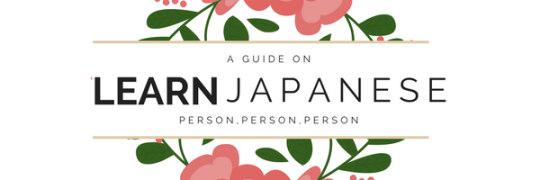
人人人・ひと、にん、じん | Person, Person, Person
Hey guys, it’s been a while! I finished submitting my last assignment for this semester of my TESOL course and am on holidays until the 26th of February! Today, at the request of @rumade (thank you very much for your suggestion ♡) we’re going to be talking about the 人 kanji and its many different uses and meanings!
人・ひと:
The word ひと means ‘person’ and can be used by itself or in combination with other kanji characters to create different words related to people or persons. A few examples include;
人々・ひとびと・People/persons.
小人・こびと・Little person/dwarf.
人質・ひとじち・Hostage.
人殺し・ひとごろし・Murderer.
It can also be used in conjunction with pronouns to say “this person”;
この人・このひと・This person.
その人・そのひと・That person.
あの人・あのひと・That person over there.
どの人・どのひと・What kind of person?
人・にん:
The word にん also means 'persons’. One of the biggest differences between ひと, にん, and じん is that ひと is the Japanese reading of the character (referred to as the kun-yomi / written as 訓読み・くんよみ) and にん and じん are the Chinese readings of the character (referred to as the on-yomi / written as 音読み・おんよみ).
While ひと is the general word for 'people’, にん is often used as a counter for people or can be used at the end of a word to represent an action, as in “a person who does (something)”.
A few examples include;
人気・にんき・Popular.
人間・にんげん・Human.
三人・さんにん・Three people.
使用人・しようにん・Employee.
支配人・しはいにん・Manager.
人・じん:
The word じん also means 'person’ and can be used similarly to にん at the start of a word to mean something related to people. A few examples include;
人生・じんせい・Life.
人口・じんこう・Population.
人種・じんしゅ・Human race.
When used at the end of a word, じん often means an attribute of a person. A few examples include;
美人・びじん・Pretty woman.
有名人・ゆうめいじん・Famous person.
老人・ろうじん・Old person.
The じん reading of the character is also used after country names to create nationalities such as;
オーストラリア人・Australian.
日本人・Japanese person.
アメリカ人・American.
Remember:
When used independently to mean person, it is read as ひと.
When 人 is used in conjunction with other characters it is likely to be read as にん orじん.
There’s no rule really to explain the difference between にん orじん when they appear at the beginning of a word, you kind of just have to memorise the reading.
When it comes to counting people, the kanji is always read as にん (with two exceptions being “1 person = 一人・ひとり” and “2 persons = 二人・ふたり”.
When it comes to nationalities, it is always read as じん.
Please let me know if you guys would like a post regarding the difference between the kun and on-yomi and when to use the different readings. Best of luck with your studies guys!
1K notes
·
View notes
Photo
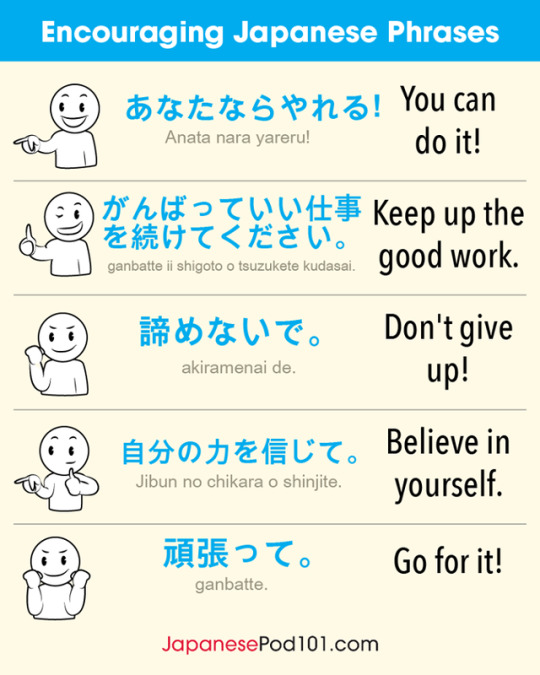
👍5 phrases for encouraging someone in Japanese!! Keep Positive! 😉
Join the fun and learn Japanese with the best FREE online resources👉 https://www.japanesepod101.com/?src=tumblr_encouraging_030318
272 notes
·
View notes
Video
youtube
FFXIV Bard Performance 詩人のパフォーマンス How to do Thok as Thok/Ravana theme (p...
0 notes
Video
youtube
FFXIV Bard Performance 詩人のパフォーマンス How to do Sophia/Equilibrium theme (pl...
(PS4 controller buttons transcribed in description)
1 note
·
View note
Video
youtube
FFXIV Bard Performance 詩人のパフォーマンス How to do 'Rise with me' theme (played...
(PS4 controller buttons transcribed in video description)
1 note
·
View note
